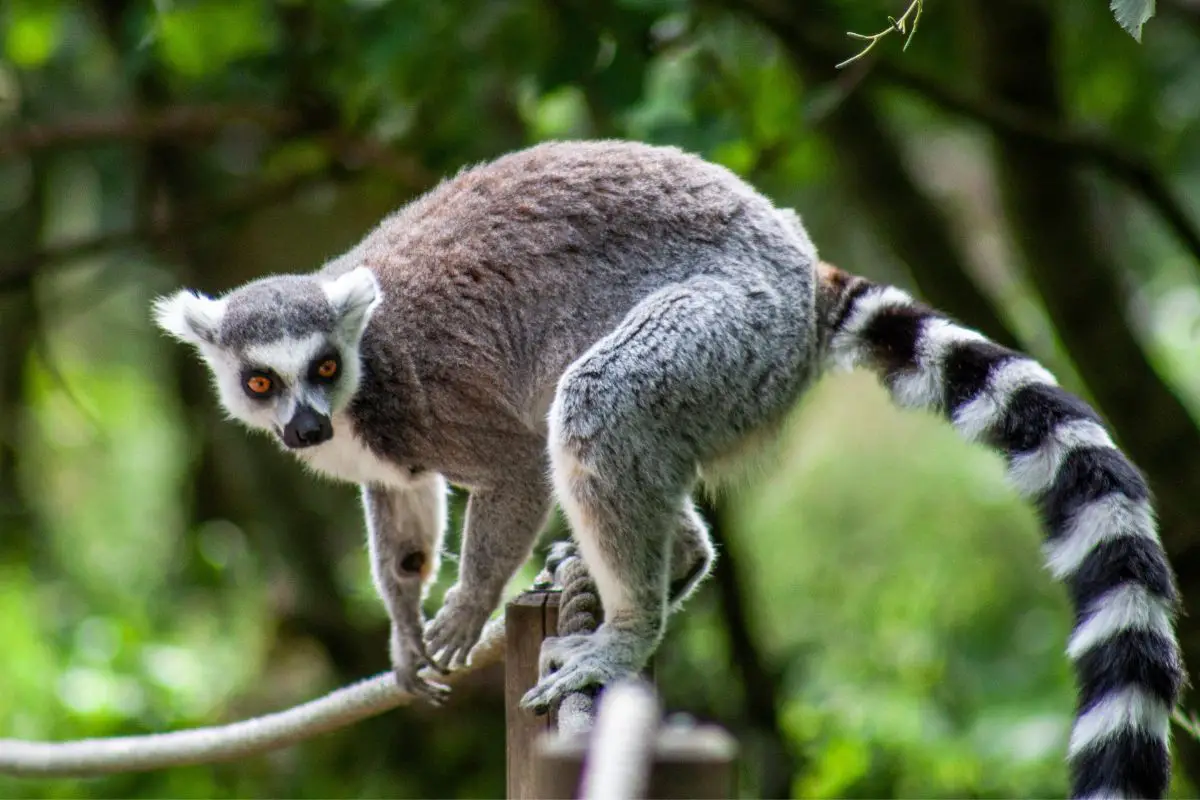
Here’s a fun fact – did you know that science considers Lemurs to be your distant cousin? Well, you may never find the resemblance when you look at one, or you may simply deny your ancestral relationship to a ring-tailed lemur. But the truth is that lemurs come from the same family as gorillas, monkeys, apes, chimps, etc.
In other words, they are one of the members of the primate species of mammals. In this wildlife guide, we will walk you through the life of the big-eyed, nocturnal mammal and present the seven most common animals similar to lemurs to you. Let this wildlife safari begin!
Life of Lemurs
Well, to tell you the truth, we cannot help but start this section by stating that there’s an abundance of monkey-like traits in a lemur. But let’s learn all about this particular kind of primate before we start to compare it with similar animals. They are unique.
Not just because of their appearance, but for their activities too. They belong to a separate branch of the endangered primate family tree – prosimians. One of their distinctive physical appearances includes having a tooth comb, which is a reformed incisor tooth on their lower jaw.
They also have a super-long grooming claw, which is a special claw on their second toe used for personal grooming. Lemurs have fantastic night vision, almost considered to be their superpower. This is because of the Tapetum Lucidum – the additional layer behind the retina of their eyes.
This is known to enhance their night vision significantly. Speaking of superpowers, they also have a strong sense of smell. This helps them forage and communicate.
But, do they like to move it, move it? The answer is yes! Similar to most primates, lemurs are arboreals – meaning they like to only live in trees. They spend their days springing from one branch to another with their mighty legs.
Sifakas, for example, are extremely skilled at jumping long distances over 30 feet, that too in one jump. Impressively flexible and strong, right? This brings us to the list of animals that are similar to lemurs in the animal kingdom.
1. Potto

Pottos are only spotted in the tropical forests of Africa, surrounding the equator. The scientific name for the potto is Perodicticus potto. They are arboreals and comfortable living in trees.
Pottos don’t move rapidly. They are, in fact, slow-moving primates. Did you know that in some parts of Africa, where natives speak in English, they refer to pottos as “softly-softly”?
These nocturnal mammals have narrow slender bodies with relatively small ears and large eyes. With almost no competition for food and shelter, they are easily able to source food by eating ants and other insects. Pottos are similar to another primate species called the Loris.
The only difference is the neck bone of pottos that distinguishes them from the Loris. Their neck bones appear as a shield on their back. The potto is usually active during nighttime, making it a nocturnal animal.
They have a particular type of cartilage at the back of their tongue that helps them clean their teeth. Moreover, their weight varies from 20 to 55 oz., depending on the size of their body. They tend to have a maximum lifespan of 26 years.
As for size, the longest potto is usually about 39 cm long, and the shortest is 30 cm long.
Pottos Vs. Lemurs
Both are primates, although the potto’s movement is not as rapid as Lemur’s. In fact, pottos have been compared to chameleons for their slow and steady movements, which makes it hard for predators to locate them in trees. Both pottos and lemurs are arboreals, but their leaping skills are definitely not the same.
Another significant difference between these two mammals is that the pottos have the ability to adapt to predators. Their backs are built with thick skin, which almost works as a shield when they are under attack.
2. Monkeys
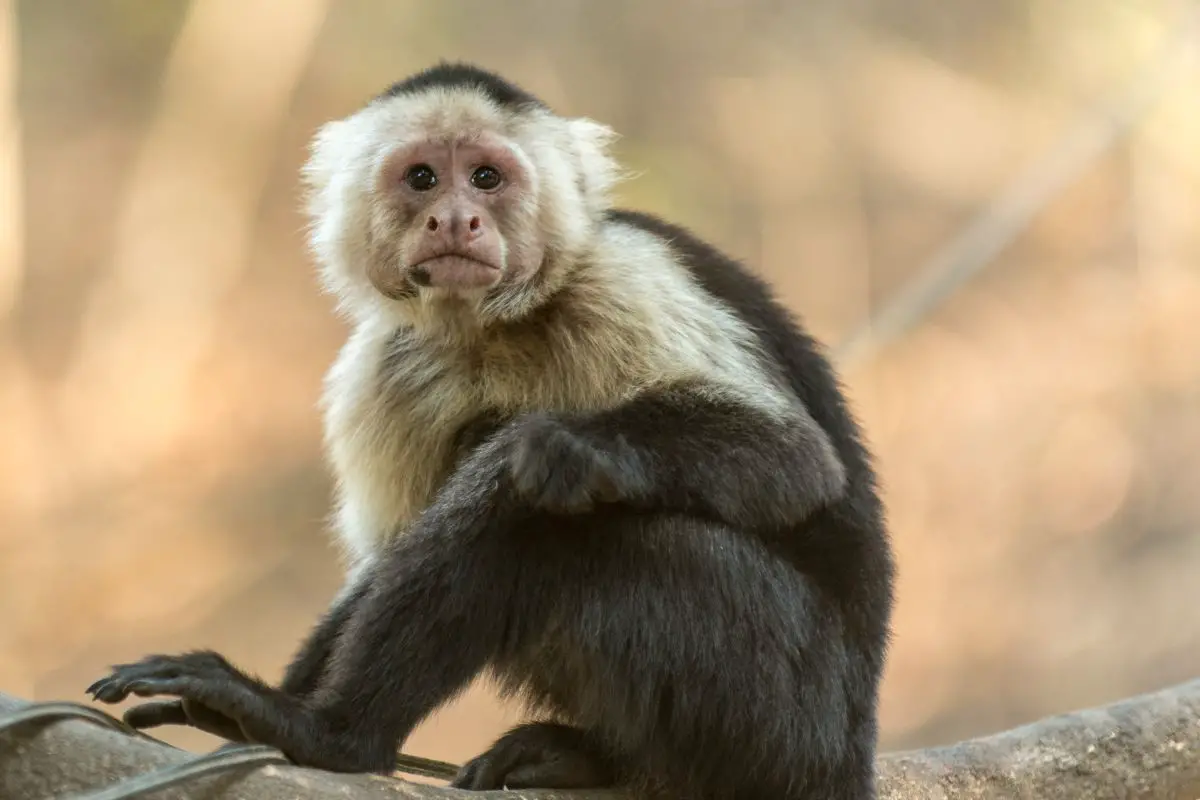
Monkeys are commonly seen all across the globe. However, in Africa, they are only spotted in dry savannah areas. If you compare them with lemurs, they are much more diverse in terms of the number of species.
For instance, monkeys have been classified into two categories – old world monkeys and new world monkeys. Old world monkeys are basically species that exist in Asia and Africa, while the latter one is from South America. There are 260 different types of species – the smallest being the Pigmy Marmoset which is only 140mm tall with a weight of four to five-ounce.
The largest, on the other hand, is called Mandrill, which stands 1 meter tall and weighs around 77 lbs. Monkeys are arboreals. They love to move, jump, leap and swing around from one tree to another.
Generally speaking, they are known to be omnivorous, so their diet includes fruits, vegetables, nuts, insects, small birds, etc. Moreover, they have a spectacular vision. They also have five fingers, including a thumb, for better grip, just like humans.
Their lifespan can be anywhere between 12 years and 45 years. They have their own ways of communicating with each other using different types of noises and facial expressions.
Monkeys Vs. Lemurs
Both of these primates have different personality traits and characteristics. The prime distinctions include their physical appearance; they are both built and shaped differently. For example, monkeys have small noses, whereas lemurs have long snouts.
As mentioned earlier, lemurs are prosimians, while monkeys are anthropoids. Lemurs generally have a better ability to sense than monkeys. Furthermore, lemurs belong to the old world primate species, while monkeys can belong to both old and new world primate species.
Lastly, lemurs are only found on the island of Madagascar, while monkeys are spread across disparate regions of the world.
3. Apes
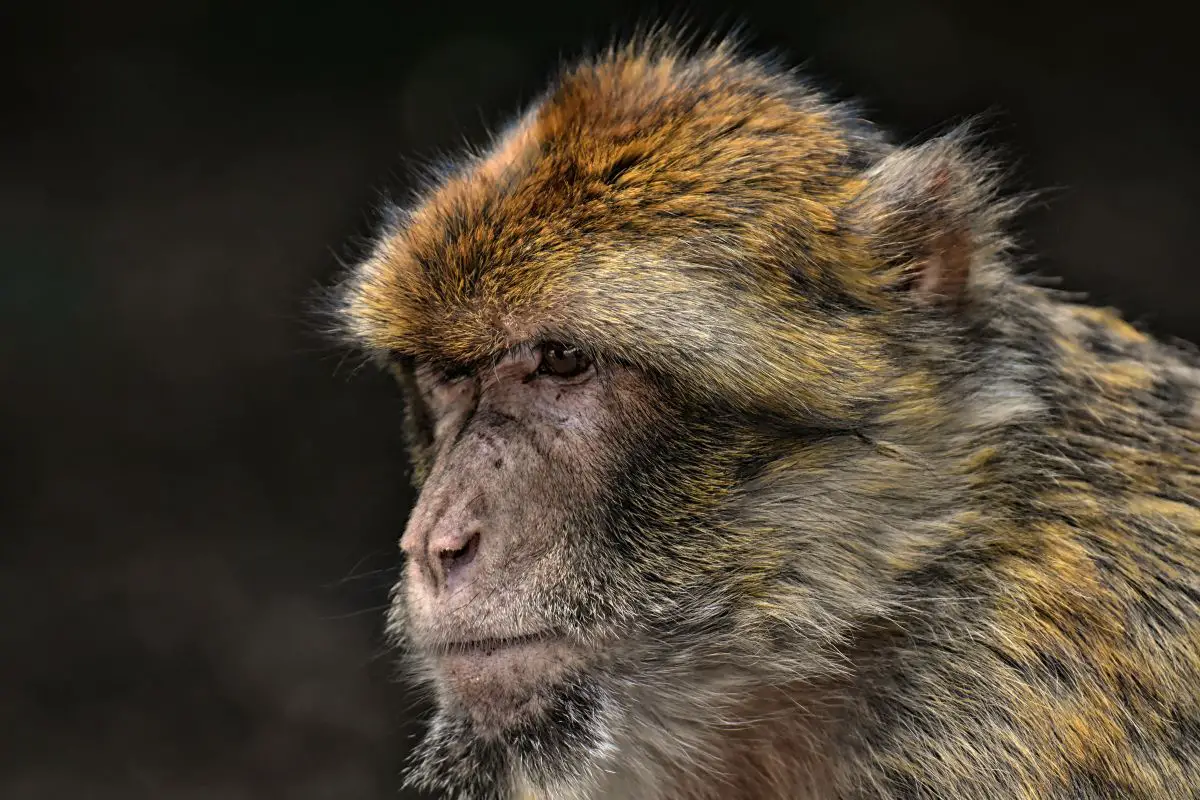
Apes are the closest animals to humans both in terms of physical appearance and personality-wise. In fact, all humans are close cousins of apes. There’s a lot of misconception about the origin of apes, and they are often called chimpanzees and monkeys.
They are similar, but not the same. But gorillas, on the other hand, are apes and are known to be the largest kind. If all this sounds a bit too confusing, let us simplify this for you.
Apes are generally divided into two groups, lesser apes and great apes. Great apes include gorillas, chimpanzees, bonobos, and orangutans, while lesser apes include gibbons and siamangs. The largest apes tend to have a standing height of 4.5 to 5.5 feet and can weigh anywhere between 200 and 450 lbs.
Now as for their habitats, according to the National Zoo, great apes are found in Africa and Asia. They like to reside in mountainous spots, savannas, and jungles. Lesser apes also live in Asia, but not in Africa.
They can be easily found in some of the tropical Asian rainforests and monsoon forests, such as in the trees of Indonesia and Malaysia.
Apes Vs. Lemurs
Lemurs and apes are cousins since they are both primates. Therefore, they share many similarities, such as living in trees. Moreover, some of the food habits also tend to be similar.
But both of these animals have a wide range of species, making it difficult to narrow down their food choices individually. Lemurs and apes differ in significant ways too. For instance, the first point of difference is the absence of the tail.
Apes don’t have tails, while some lemur species do. In addition, there are numerous other dissimilarities between apes and lemurs in terms of their physical traits. Apes are much bigger in size and shape too.
Their intelligence level is also not the same. Apes have amazing communication skills and can even use tools to overcome hurdles, just like humans.
4. Galago

Another primate known as bush babies or Galago is native to the Saharan region in Africa. Galagos typically enjoy eating everything from tree saps to spiders and snakes. One of their specialty is that they are able to turn their necks completely by 180 degrees.
Galagos are known as bush babies because of the sound of their cries, which is very similar to the crying sound of human babies. They are really adorable appearance-wise, which is why many people keep them as pets too. Galagos demand considerable territory for their living, so keeping them as pets is not for everyone.
Galagos are nocturnal animals and have tremendous jumping skills. These primates also like to groom themselves daily. Galagos have large eyes and excellent night vision too.
Similar to some other primates, they have comb-like tooths, and their diet consists of fruits, tree saps, insects, spiders, and some other small animals.
Galago Vs. Lemurs
Lemurs and galagos have a lot of similarities. Many of their characteristics match, such as grooming. Both these animals spend a large part of their days grooming themselves.
Moreover, their diet is also quite similar. As you know, lemurs typically eat everything from fruits and leaves to small insects, just like galagos. Lemurs and galagos are excellent jumpers with powerful legs and the flexibility to leap long distances.
The significant difference lies in the ability of galagos to turn their necks fully to face their backs. A lemur’s physical structure does not allow it to do so.
5. Loris
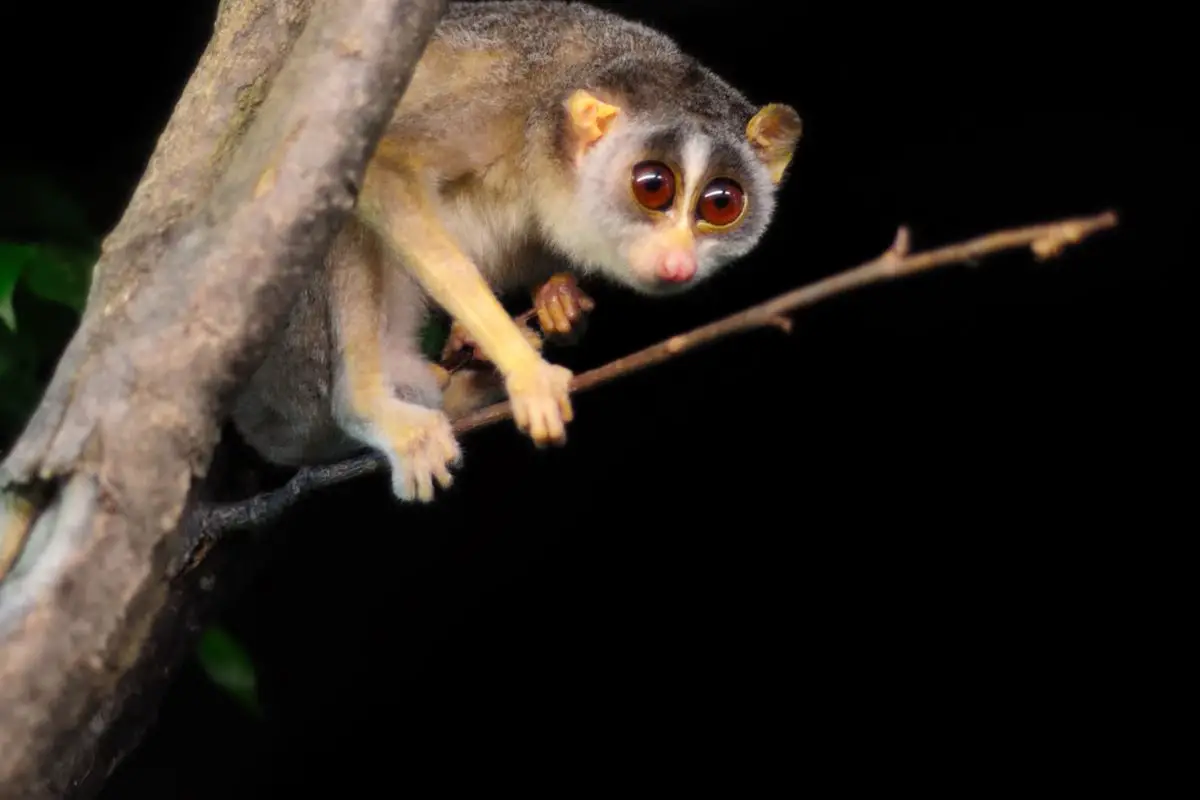
Loris is a species of the Lorisidae family. There are three kinds of Lorises, Slender Loris, Pygmy Slow Loris, and Slow Loris. The Lorisidae family also consists of galagos and pottos.
Both Slender Loris and Slow Loris are typically found in Africa. And not only that but only in the southern part of Africa and in parts of Asia such as Sri Lanka, East Indies, and southern India. In addition, some lorises have tails, while others don’t.
However, some might have very small tails – so small, in fact, that it might seem as if they don’t exist at all! You might also be interested to know that their heads are round in shape, and they have large eyes and small ears. On top of that, their ears are completely covered by their furs.
All kinds of lorises are able to grab things easily, owing to their powerful fingers and toes. They are also able to grip objects and surfaces for a very long time. They tend to be arboreal and nocturnal by nature.
Most interestingly, they sleep inside hollowed tree trunks. One of the things they are known for is their rapid movements. However, they are not the best at leaping, especially compared to some of the other animals mentioned in this guide.
In terms of diet, the Slender Loris mostly feed on insects, leaves, slugs, and eggs. Disturbingly, lorises are superstitiously believed to contain medicinal powers in some parts of the world, which is why they are a popular target among hunters and poaches. As a result, their population is declining with time, and they are considered endangered animals.
Loris Vs. Lemurs
Lorises are slow-moving primates, unlike lemurs. Although they are both primates, they belong to different families. The prime similarity between these two animals is that they both have long snouts and rhinarium. Their diet also consists of similar things, such as leaves and insects.
However, some lorises eat clogs and eggs, while lemurs don’t. Lemurs are fussy eaters. If they are not able to source food that they regularly feed on, they will conserve their energy until they find their food.
6. Tarsier
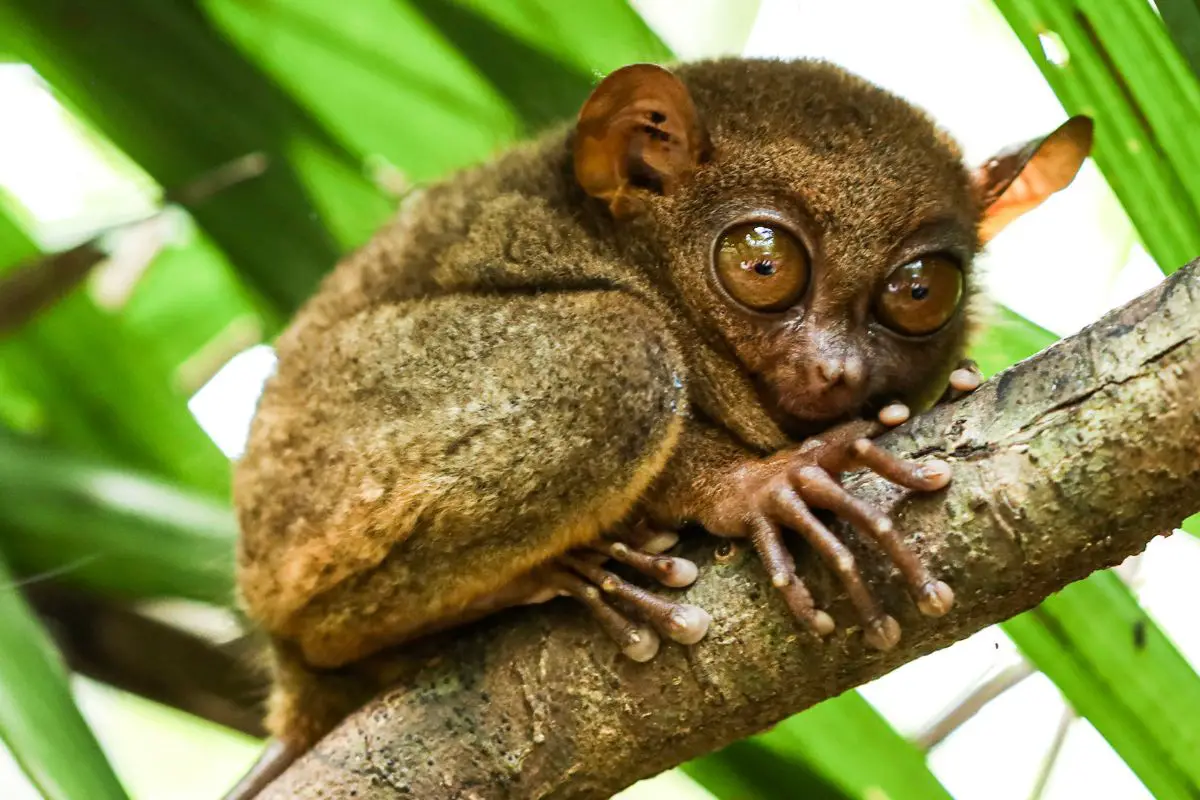
Currently, Tarsiers are only found in some Southeast Asian islands. For example, you can find them in Borneo, Sumatra, other Indonesian islands, and the south of the Philippines. There are currently six different species of tarsiers.
Sulawesi is another place where a certain kind of tarsiers can be spotted. Other than this, there are two more species that were found – one in the Philippines and another around the islands of Sumatra and Borneo. Among them, one species of Tarsier has already been listed as an endangered species, and fears are that many more can go that way.
The main culprit behind this trend seems to be deforestation on a massive scale. Unfortunately, tarsiers don’t survive in captivity, not even as heavily cared-for pets. They enjoy clinging to trees, and it is not unusual for them to shy away from human beings.
However, they do allow gentle poking and touching sometimes. But for the most part, they prefer to be left alone. They are primates and prosimians.
They have large eyes, which are almost the size of their brain. They are active at night and feed on insects, small birds, and reptiles.
Tarsier Vs. Lemurs
Tarsiers and lemurs are commonly compared to each other. That is because some scientists suggest that they should be classified as monkeys and apes, while others feel that they are prosimians like lorises and lemurs. Yes, they are similar in many ways.
For instance, their eating habits and nature are quite similar, but they differ in terms of their appearance. For instance, their nose structures are not the same. Moreover, lemurs have a reflective material that exists behind their iris, while tarsiers don’t have this.
7. Marmoset
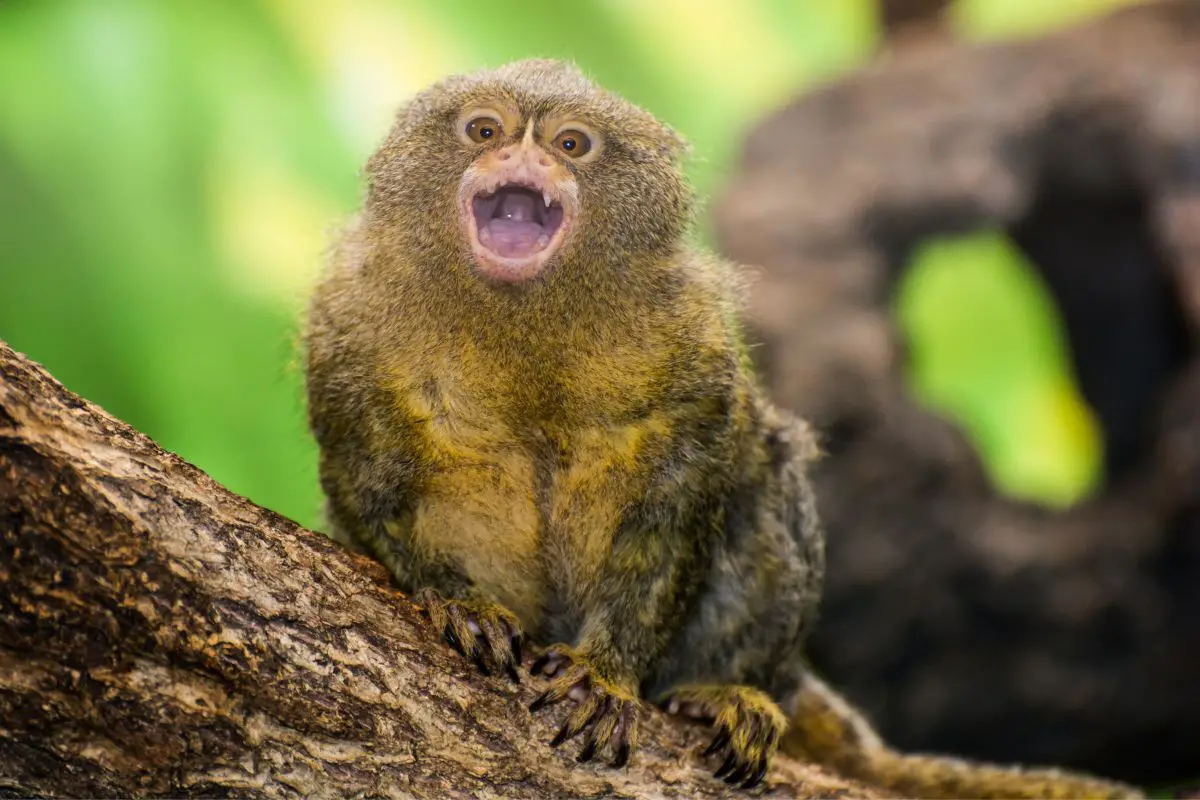
Marmosets, scientifically known as Callitrichidae, fall under the species called New World monkeys. But they are tiny in size. There are 25 different species of marmosets with an average height of eight inches, excluding the tail.
You might be surprised to know that monkeys are marmosets too. Usually, a marmoset’s tail is almost as long as its entire body. Marmosets always reproduce with fraternal twins, which means that they carry the ovum of their fraternal twin, a completely different DNA from their own.
Marmosets have another name, which is Zaris. They are native to the South American region and are found in countries like Peru, Bolivia, Brazil, Ecuador, Colombia, and Paraguay. They live comfortably in the upper canopy of forest trees and feed on leaves, fruits, insects, tack, sap, and gum.
A typical marmoset family consists of between three and fifteen members. Among them, you are likely to find two breeding females, their offspring, a male who is not related to them, plus other extended family members.
Marmoset Vs. Lemurs
Marmosets and lemurs are primates and hence have many habitual similarities, such as living in trees and feeding on leaves and small insects. However, lemurs have more species compared to marmosets. Moreover, as mentioned above, the extent of their geographical existence is completely different.
For instance, lemurs are only found in Madagascar, but marmosets are more extensively spread across the globe. Additionally, there is a special species of blue-eyed lemurs. But there are no marmoset species with blue eyes.
FAQs About Animals Similar to Lemurs
What Is the Most Fun Fact About Lemurs?
As far as the lemur world is concerned, we can say that their society perfectly exemplifies the concept of female power. Lemurs are excellent at forming their own social circles, and usually, it is always a female in the lemur group that is seen to take charge. This is not a very common scenario in the animal kingdom.
The males always take the lead. But for lemurs, females are more authoritative and territorial, and they pleasure in displaying their dominance by marking their turfs. Another fun fact about lemurs forming their groups is that they move in troops, but the number of members can vary depending on the species.
You may notice up to 20 members in one single group or just a small group of 2 or 3 lemurs.
How Did They Find Their Way To Madagascar?
If you look at the world map for reference, you’ll notice that Madagascar is located around the east coast of Africa. It is an independent nation with a population of 29 million people. So how did these mammals make their way to this beautiful island?
Research and studies state that lemur’s ancestors made their way into Madagascar about 65 million years ago. Now, the most interesting part is that they are believed to have made it there with the help of rafts on floating vegetation.
Are Lemurs Diurnal or Nocturnal?
Once again, since there are so many different species of lemurs, this question is not so easy to answer. Some lemurs like Indri are active in daylight, while others are nocturnal. On the other hand, nocturnal lemurs – lemurs that are active at night – include mouse lemurs.
However, it’s safe to say that there are lemurs who are cathemeral too. They like to live a hybrid life of being active at both times of the day, depending on their habitat and food source. Moreover, their active hours can also vary depending on the seasons.
There are some species that are bound to go through a season of torpor when they are fully inactive due to a scarcity of food, almost like hibernation. Sometimes, during this period, lemurs can go into dormancy for up to 6 months. The strategy is to preserve the energy until they are able to forage again and protect themselves from predators.



